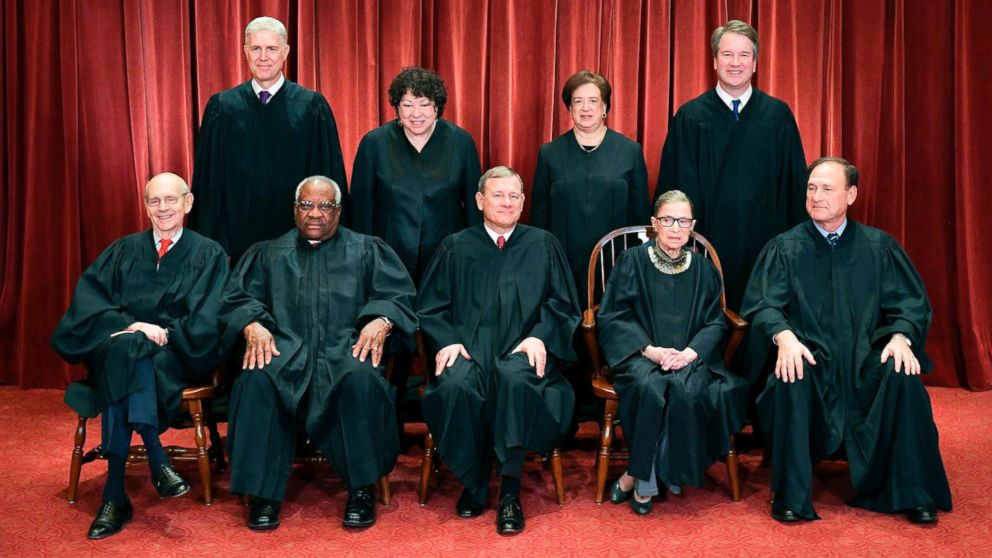
U.S. Vice President Mike Pence has a problem with Supreme Court Chief Justice John Roberts. “Chief Justice John Roberts has been a disappointment to conservatives … The destiny of the Supreme Court is on the ballot in 2020,” he said this week.
Vice President Pence is right: the Supreme Court has a problem.
It’s the same problem that it has had since 1972. And it has nothing to do with Chief Justice Roberts.
For 48 years, the highest court in the United States has been controlled by members of the same political and judicial family: conservative justices appointed by Republican presidents.
Since 1972, in the course of elections, Democrats and Republicans have swapped control of the White House and of both houses of Congress. Republicans have been elected to the White House a little more often (28 years versus 20 for Democrats); Democrats have controlled Congress a little more often (26 years controlling the Senate versus 22 years for Republicans). In short, Americans have chosen to put their eggs in two relatively equal baskets since 1972.
The opposite situation has taken place on the Supreme Court.
Over the course of the last 48 years, conservative justices appointed by Republican presidents have made up the majority of the court. For 48 years!
The most progressive justices, appointed by Democratic presidents, have been in the minority there since 1972.
This anomaly has had significant consequences over the long term, observed American author and journalist Adam Cohen in his book “Supreme Inequality,” published earlier this year. Armed with its five-decade majority of conservative justices, the Supreme Court has slowly pulled the country further to the right than it actually is.
Some examples? It tore several electoral finance reforms to shreds. It ensured, in the name of freedom of expression, that rich donors could spend as much as they want when it comes to elections. It endorsed education funding that favors schools in rich areas (predominantly white) at the expense of schools in poorer areas (predominantly Black).
One or more conservative justices sometimes cross party lines and vote with the progressive justices. Justice Anthony Kennedy played this role until his retirement in 2018. It was he who enabled the right to abortion in Roe v. Wade in 1973, the right to same-sex marriage in 2015 and, more recently, protection of the status of “Dreamers” in 2020.
Many Americans are conservative, and the judiciary should represent this. The problem is that the conservative movement has controlled the Supreme Court for 50 years, while American society has much more nuanced points of view on many of the issues being decided by the highest court in the country.
How has the Supreme Court remained under conservative control for such a long time? In three years, from 1969 to 1971, Republican President Richard Nixon was able to appoint four (conservative) justices to the Supreme Court. Because justices are appointed for life, as stipulated in the Constitution, they decide when they retire and, above all, which president names their successor. In this respect, the conservative justices of the Supreme Court have been shrewder than the progressive justices. The last six very conservative justices chose to retire when a Republican president could appoint their successor, as opposed to only one out of six very progressive justices who saw their successor named by a Democratic president.
It’s why progressive Supreme Court Justice Ruth Bader Ginsburg, who will be 88 years old on Saturday, is still on the bench despite her health problems. She does not want Donald Trump to choose her successor.
Is it possible to make the U.S. Supreme Court more representative of American society? The solution exists. It is alive and well in Canada: justices must retire at 75 years of age. But to set a mandatory retirement age for justices in the United States, it would be necessary to amend the U.S. Constitution, which is practically impossible. (It has happened only two times in the 20th century: for the right of women to vote in 1919 and for the right to vote starting at age 18 in 1971).*
So round and round we go. And it does not bode well for American society that it recognizes itself less and less in its Supreme Court.
*Editor’s Note: The Constitution was amended more than twice during the 20th century.

Leave a Reply
You must be logged in to post a comment.